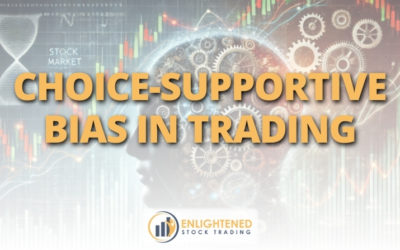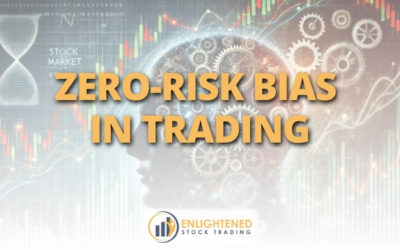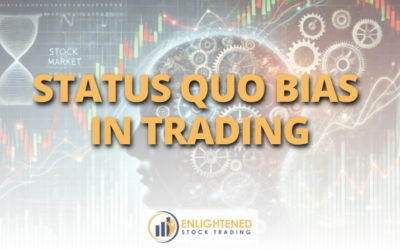Markets may seem chaotic, but price movements often follow natural cycles. The Hurst Cycle, named after American engineer J.M. Hurst, provides a framework for understanding stock market cycles and improving trade timing. By analyzing cyclic theory, traders can identify price peaks, price troughs, and key turning points across multiple time frames, from the daily chart to the weekly cycle. This...
Adrian Reid

Trading with Percentage of Stocks Above Moving Average Made Easy
The percentage of stocks trading above a moving average is a market breadth indicator that measures how many stocks in an index or market are trading above a specific moving average level. Market analysts and investors use this metric to assess the overall strength or weakness of the market. To put this in simpler terms, imagine you are looking at a race where hundreds of runners are competing....
Paralysis by Analysis in Trading: Why More Data Doesn’t Mean Better Trades
Paralysis by analysis occurs when overthinking leads to inaction. A trader sits surrounded by six monitors, each crowded with charts, indicators, and news feeds. They've spent three hours analyzing a potential trade, checking every timeframe, reading dozens of analyses, and still haven't placed the order. Meanwhile, the perfect setup they spotted hours ago has already moved without them. This...
Choice-Supportive Bias in Trading: How to Stay Objective & Avoid Costly Mistakes
Choice-supportive bias is the tendency to justify past strategic decisions retroactively by exaggerating their benefits and downplaying their flaws. This might look like someone buying an overpriced car and later convincing themselves it was a “great deal” despite better options. This is one of many cognitive biases explored in trading psychology that influence financial decisions and impact...
Overconfidence Bias in Trading: How to Trade with Confidence, Not Arrogance
Overconfidence bias is the tendency for individuals to overestimate their knowledge, skills, or control over outcomes. According to research, overconfidence is usually driven by other cognitive biases, such as self-attribution bias, optimism bias, and the illusion of control bias. The same paper found that the illusion of control was the strongest predictor of risk-taking and investment decision...
Breaking Free from Outcome Bias in Trading for Smarter Decisions
Outcome bias happens when traders judge the quality of a decision based solely on the result, not the process behind it. Imagine driving home drunk and arriving safely. Was it a good trade? Of course not. The outcome was positive, but the decision-making process was flawed. Most traders would celebrate a colleague who bet their entire account on a single cryptocurrency trade and doubled their...
The 40+ Best Trading Books of All Time: Must-Reads for Every Trader
There are many great trading books but finding the one you need can be difficult. We have reviewed many outstanding books, grouped by trading system topic to help you find what you need.
How Zero-Risk Bias in Trading Leads to Missed Opportunities
Zero-risk bias is the human tendency to prefer absolute certainty, even when it’s not the most rational choice. These cognitive biases stem from an adaptive tendency to minimize unnecessary risks, even at the expense of long-term rewards—a concept frequently explored in trading psychology. It’s why people choose a “guaranteed” small win over a higher potential reward with minor menace, often...
Overcoming Status Quo Bias in Trading for Better Market Decisions
Status quo bias is our natural tendency to prefer things as they are, even when change might lead to potential benefits. It’s the reason an investor sticks with an outdated phone, stays in an unfulfilling job, or keeps an underperforming stock. This bias is one of the most prevalent behavioral biases affecting financial products and the stock market—and it's a recurring topic in trading...
The Ultimate Guide to Successful Trading
Proven Strategies for Successful TradingSuccessful trading requires more than just good luck. It's about implementing a systematic approach, mastering risk management, refining your trading plan, and building a resilient mindset. In this guide, we'll walk you through everything you need to know to build consistent profitability and confidence in your trading journey.📈 What is Successful Trading...
Stock Market Definitions
Understanding the most common stock market definitions is helpful for new traders to increase their rate of learning and reduce overwhelm. This page provides clear, beginner-friendly explanations of fundamental stock market terms, including Bear Market, Blue Chip Stocks, Market Capitalization, IPOs, and more. Learning the language of the stock market helps traders understand various concepts...
Risk Management Definitions
Understanding risk management definitions is essential for anyone looking to protect their capital and enhance their trading performance. This page provides clear, beginner-friendly explanations of the most important risk management concepts, including Alpha, Beta, Diversification, Stop-Loss Orders, and more. Knowing these definitions will help you make better decisions when managing your...












